#Victorian knitting
Text


Knitting in Victorian England
I wrote this for a class on Victorian Literature because my professor let me research knittinf and make a cape instead of writing a literary analysis paper. The cape that is discussed from The Art of Knitting is what I created for this project, with the illustration from the book on the top right and the cape I knit on the left. The book is from 1892 and is free on Internet Archive, and Engineering Knits on YouTube made a wonderful video about it. (More photos of the cape at the end!)
Knitting experienced a surge of popularity in Victorian England, and was even a topic of discussion in Charlotte Bronte’s Jane Eyre. After gaining popularity due to industrialization, knitting became a common pastime for women. Knitting was important because it existed as a way for Victorian women of all classes to be seen as virtuous and gave them the look of domesticity, while additionally functioning as a means of income for working-class women by either knitting or writing about knitting.
Industrialization shifted the view of knitting from economic necessity to a fashionable pastime for gentry women. In 1589 the first mechanical knitting machine was invented in Nottingham, which industrialized the knitting industry (“The History of Hand-Knitting"). Dyed wool trade with Germany and the subsequent booming industry of knitting pattern books turned knitting into something more accessible and artistic than solely practical (Rutt 112). Knitting became popular and fashionable for gentry women around 1835 (Rutt 111). Women of all classes have knitted long before the Victorian period, but the industrial changes shifted knitting to a popular and fashionable pastime for gentry women, in addition to the economic necessity for working-class women.
Knitting served as a way to keep women wholesomely busy. In The Art of Knitting, a quote from the beginning by Richter reads “A letter or a book distracts a woman more than four pair of stockings knit by herself” (qtd in The Art of Knitting 2). Knitting kept women busy without opening them up to new ideas that came from letters and books. Furthermore, a writer in The Magazine of Domestic Economy writes how useless the items (upper-class) women made were, but praises knitting in its effort “to rid of those hours which, but for their aid, might not be so innocently disposed of” (qtd in Rutt 112). Concentrating on knitting produces something at the end of the hours of challenging work but does not expose women to any material that the Victorians would deem dangerous or immoral. Thus, even when women made something useless, they were keeping themselves busy in a virtuous way.
Knitting also gave women the feminine and domestic look that was expected of them in the Victorian era. This can be seen in Jane Eyre with Jane’s description of Mrs. Fairfax upon their meeting. Jane thinks, “[Mrs. Fairfax] was occupied in knitting; a large cat sat demurely at her feet; nothing in short was wanting to complete the beau-ideal of domestic comfort” (Bronte 145). This is the first time the reader sees Mrs. Fairfax, surrounded by a warm fire, a cat and engaged in a feminine pastime. She is the image of domesticity. Jane admires Mrs. Fairfax, in part, for the comfort her nature, including knitting, brings. Mrs. Fairfax shows the role knitting plays into the idea of women as domestic creatures.
Certain forms of knitting made women appear elegant. Frances Lambert, author of 1842 manual The Handbook of Needlework, advises women to knit using the common Dutch knitting method, in which the yarn is held over the fingers of the left hand and the needles pointed upwards, because it was seen as a more elegant style of knitting (Rutt 113). While Rutt notes that this method was a faster way of knitting, Lambert does not comment on this, but instead focuses on its aesthetic qualities. This style of knitting was popular because it allowed for the look of style that was mandatory in women’s lives.
While gentry women were often restricted to making less practical knit items, some knitting authors disparaged this for frivolity and immorality. Working-class women did not have this criticism as the things they made were out of practicality and meant for regular use. In picking yarn color and material, Mlle Riego de la Branchardiere, author of Ladies Handbook of Knitting, Netting and Crochet writes “...and let her be careful to make all she does a sacrifice acceptable to her God” (qtd in Rutt 116). Rutt asserts that although Victorian knitting is seen as producing useless knits, some authors disparaged this (117). They instead encouraged women to focus on what they saw as the spiritual aspects rather than on aesthetics, as everything women did, including knitting, should enhance their virtue.
While knitting was popular as a pastime, it was still used out of economic need and served as a way for working-class women to earn money. Knitting was taught in orphanages and poor houses, with the first knitting school opened in Lincoln, Leicester, and York in the late 1500s. One school in Yorkshire was established for boys and girls who were “not in affluence” (“The History of Hand-Knitting"). The first knitting book, titled The National Society's Instructions on Needlework and Knitting, published in 1838, was an instructional manual for teachers to teach poor students the art of knitting and needlework. Knitting was used as a personal hobby, but also as a way for working-class people to support themselves.
The importance of knitting to working-class women can be seen in Jane Eyre. St John tells Jane, “It is a village school: your scholars will be only poor girls—cottagers’ children—at the best, farmers’ daughters. Knitting, sewing, reading, writing, ciphering, will be all you will have to teach” (Bronte 541). Knitting will be a way for these young girls to get jobs and to be able to make clothes for themselves and their families. In this way, knitting was more than a fashionable and artistic hobby, but a necessity for many working-class women.
In addition to manufacturing knitwear, women were able to make substantial livings writing about knitting. There was a boom in knitting and needlework publications during the 19th century (“The History of Hand-Knitting"). Some, such as The Art of Knitting, were published directly by publishers with no one associated author. Others were authored by women and were immensely successful. Cornelia Mee, who published shorter pamphlet-type knitting books, sold over 300,000 copies during their run in print (Rutt 115). Francis Lambert, author of two editions of My Knitting Book, sold a combined 65,000 copies and was translated into several languages across Europe (Rutt 113). Knitting gave working-class women opportunities to earn money, whether it was making knitwear or writing about knitting.
Knitting manuals contained various topics, such as some focusing on the religious and virtuous aspects of knitting as discussed previously, but most, if not all, had patterns in them. Under the chapter “Hoods, Capes, Shawls, Jackets, Fascinators, Petticoats, Leggings, Slippers, etc., etc.” in The Art of Knitting there is a pattern to knit a cape. Victorian knitting patterns tended to be broad and vague. Today's patterns are quite concerned with needle size and gauge, unlike many Victorian patterns. For instance, the cape pattern instructs the reader to “use quite coarse needles and work rather loosely,” (60).
Knitting was an important skill for women in the Victorian era, and they knit for a multitude of reasons. Knitting gave women the look of virtue, elegance, and domesticity. Working-class women used their knitting skills to support themselves and their families through making knitwear or writing about knitting.
Sources:
The Art of Knitting. The Butterick Publishing Co. 1892. https://archive.org/details/artofknitting00butt/page/60/mode/2up?ref=ol&vi ew=theater
Bronte, Charlotte. Jane Eyre. Planet eBooks. 1847.
“The History of Hand-Knitting" Victoria and Albert Museum.
Rutt, Richard. A History of Hand Knitting. Interweave Press. 1987. https://archive.org/details/historyofhandkni0000rutt/page/n7/mode/2up?vie w=theater


#knitting#historical knitting#history bounding#Victorian knitting#knitting history#cottagecore#victorian#knit cape#gothic#slow fashion#handmade#my knits
163 notes
·
View notes
Text



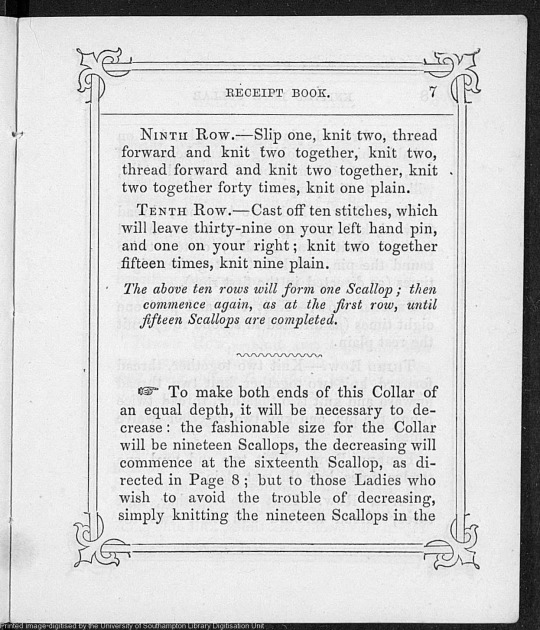
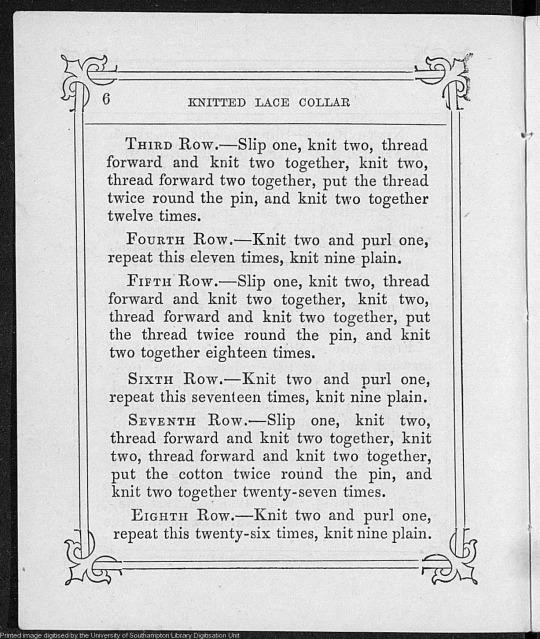


Pattern for lace collar no. 1 is above, Lace collar no. 2 is below!


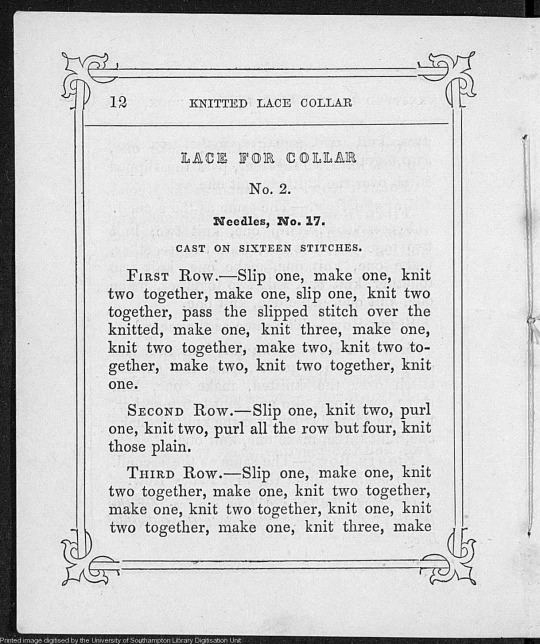

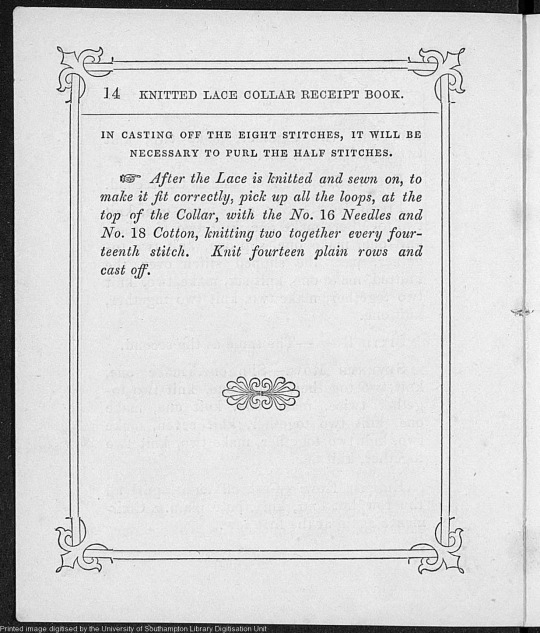
Today we have a big dump of victorian knitting patterns from 1846 by Mrs. G. J. Baynes!
Just saw that tumblr fixed the image issues and upped the max image amount and it's wonderful. Now I can do these two without having to break them up into parts!
The alt text for some reason doesn't let me backspace anymore to correct mistakes, so I have to use notepad to transcribe, but all in all it's much better haha.
an fyi for newbie knitters, make refers to increasing. so Make one is increase one.
CORRECTION: It was brought to my attention by @the-fibre-stuff that it's supposed to be yarn over/ yarn forward stitch and not the M1 or M1l Stitch. Big thanks to them for pointing that out! and you can see photos of my (failed) sampler attempts in my reply to them!
Bonus image:

#knitting#historical knitting#historical knitting patterns#victorian knitting#victorian#early victorian#1840's#1840's fashion#victorian knitting patterns#collars
93 notes
·
View notes
Text

I finished my stockings using a pattern from 1870! The Stockings Knitters Manual is really great and easy to understand. I have some extra notes on my ravelry if you want to knit them too :)
#knitting#stockings#Victorian stockings#Victorian knitting#historic knitting#historic fashion#i love the Technicolor red of the yarn
15 notes
·
View notes
Text

Knitting girl (1888) by Albert Anker
#Knitting Girl#Albert Anker#1880s#Victorian#Victorian painting#art#painting#knitting#knitblr#Miss Cromwell
564 notes
·
View notes
Text







Victorian Neck Warmer - NEW in my Etsy Shop!
Material: 100% microfibre
Neck circumference, relaxed (stretchy): 38 cm / 14.5 in
Width: 21 cm / 8.5 in
For this and many other handmade, unique items please visit my Etsy Shop.
Alternatively, please remember that you can always get a 10% discount on this and any of my handmade items by contacting me directly on Tumblr and completing the purchase via Paypal.
Please help support your friendly crafter by reblogging this post. Thank you!
#Crochet#Knitting#Victorian#Fall#Neck Warmer#Yarn#Handmade#Yarnporn#Fiber art#Textile arts#Etsy#Etsy Seller#My crochet
172 notes
·
View notes
Text


Tao for Comme des Garçons: Wool Laced Knit Victorian Corsets (2006)
1K notes
·
View notes
Text
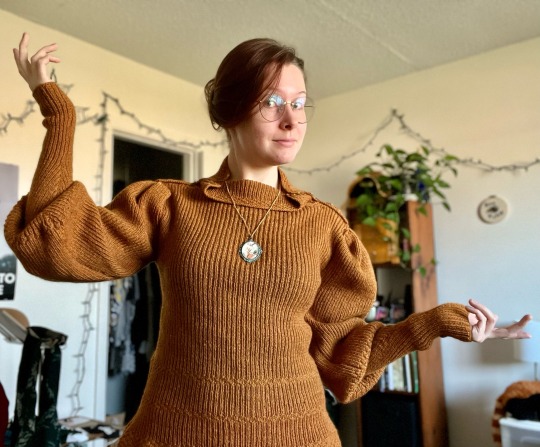

give it up for Big Ass Sleeves!!!!!!!!! and yes we are making CHOICES with the collar bc My Sweater, My Lack of fucks to give when the gauge got so so fucked
#look at it!!!!#the way i’m dealing with the collar is Disheveled Whimsy thanks very much#knitting#knitblr#victorian#cycling sweater#look what i made
478 notes
·
View notes
Note
I'm sorry for flooding your notifications, but I love this blog so much!
I'm wondering how to keep a mid 19th century man warm during the winter, especially if he enjoys staying outside for long periods of time.. What was in style during the winter? And did they wear scarves or beanies like we do today?
Not a silly question at all! For his basic winter top layer, he'll wear an overcoat with a surprisingly modern cut, like these two examples of Chesterfields from A Practical Guide for the Tailor's Cutting-room (1848).
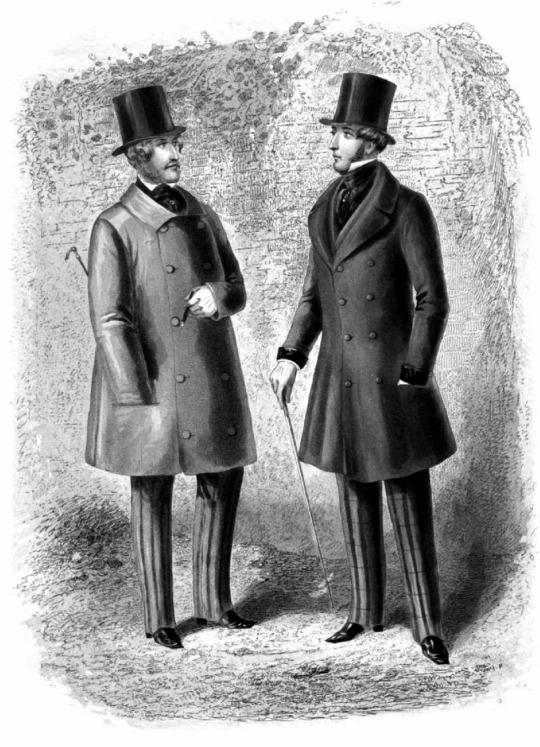
But layers and accessories can make this much warmer. Of course he loves his comforter, as he calls it—a woolen scarf for wrapping around the neck.
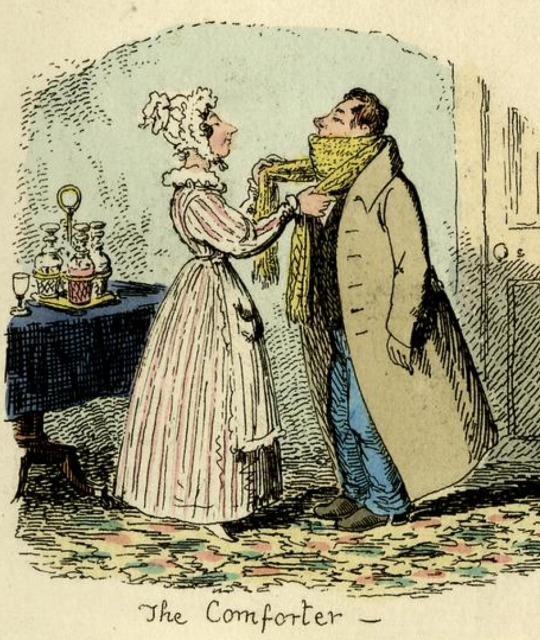
A comforter by George Cruikshank, 1831.
You can find knitting patterns for comforters, muffetees, chest protectors, and other gifts for your 19th century man that will keep him warm, comfortable, and safe from draughts.


Even the adventurous winter lifestyle is accomodated with these knit caps for gentlemen, both from The Art of Knitting (1892).
80 notes
·
View notes
Text
My lovely prism shawl. Probably the creation I'm the proudest of.
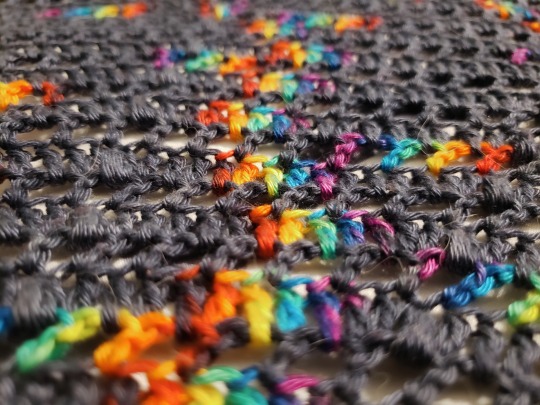

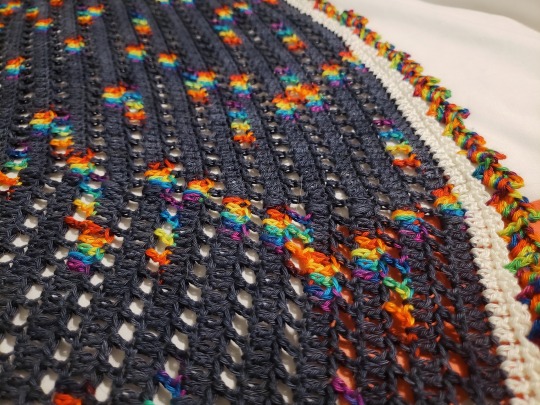
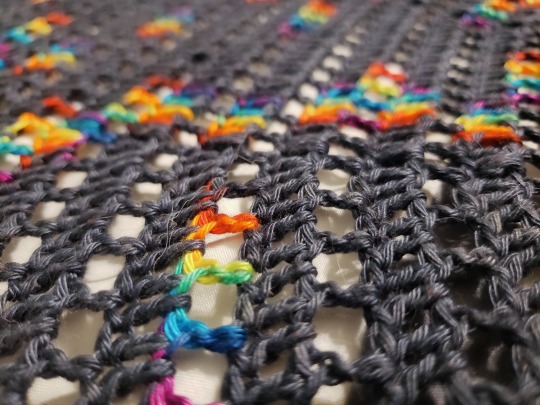
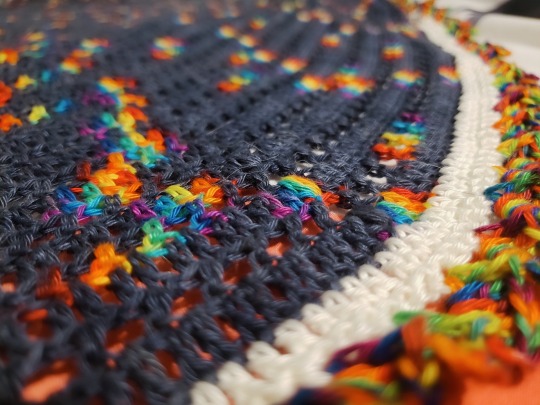
#mine#photography#cute#handmade#crochet#knit#fashion#craft#black#goth#Rainbow#fiber crafts#Shawl#Prism#Sale#for sale#knitting#Custom#Victorian#style
466 notes
·
View notes
Text

"Group of market-bound women pose with baskets slung over head to free hands for knitting" (detail), Claddagh, County Galway, Ireland. Alexander Robert Hogg. National Museums NI.
#ireland#irish#women#claddagh#galway#baskets#knitting#vintage#history#victorian#edwardian#laughter#laughing
47 notes
·
View notes
Text






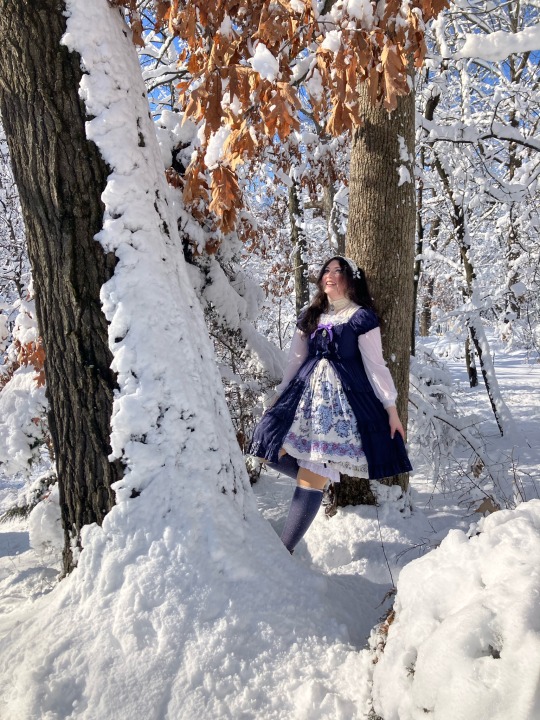
winter wonderland ❄️
OP: Victorian Maiden
JSK: Alice and the Pirates
Blouse: Gunne Sax
Headdress: Innocent World
Bow scarf: Liz Lisa
Socks: offbrand
My parents’ backyard was just magical when I visited them earlier this month, and we had a warm and sunny day so I had to take photos! I’m laughing in the last one because snow kept falling on me from the trees haha.
#lolita fashion#egl fashion#victorian maiden#innocent world#classic lolita#egl community#mine#the skirt peeking out in some pics is also IW#was just using that for volume lol I didn’t bring a petti#the bloomers are melikestea and the shawl is my mom’s orenburg lace shawl#really want to knit one myself I have some brown lace weight wool yarn stashed but just haven’t gotten to it yet#like using an Orenburg lace pattern I know I don’t have the correct wool technically but idc
47 notes
·
View notes
Text

A c.1850s pair of gloves. The colorwork is an early example of Fair Isle, while the pointed finger tips suggest a possible influence from Eastern European or Scandinavian techniques.
184 notes
·
View notes
Text
Reading an old knitting pattern, and one of the abbreviations was "n."
From context I was pretty sure it was a decrease, but to be certain I looked it up.
It is, in fact, the same thing as "knit two together," and the book uses both of these.
The "n" stands for "narrow."
#oh you funky victorians#if you couldn't figure out what “n” means in your antique pattern try decreasing I guess?#1890s#knitting
32 notes
·
View notes
Text

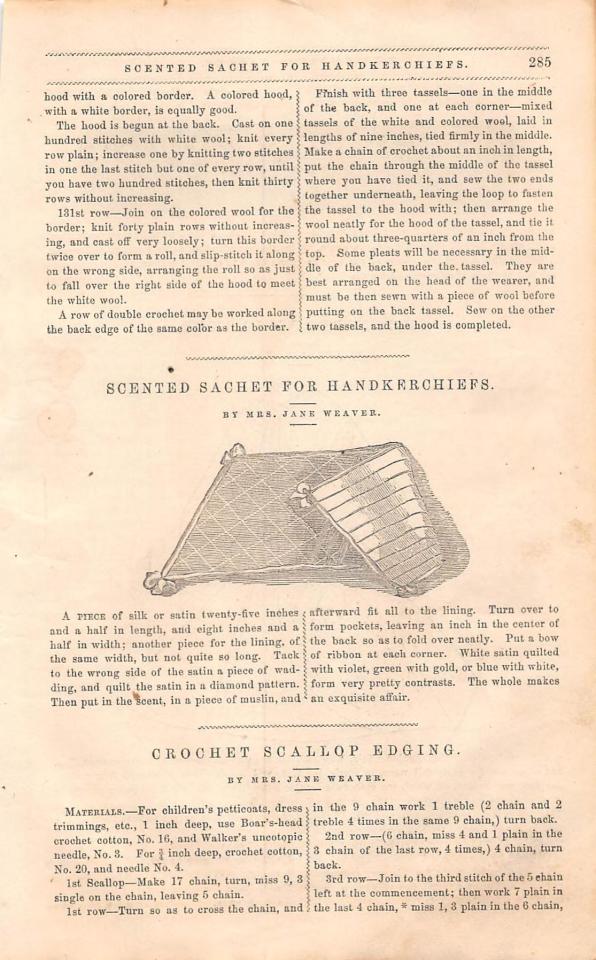
#knitting pattern#knitting#victorian history#fashion#historical#history#historical clothing#victorian era#victorian#victorian fashion#high fashion#historical fashion#magazine#fashion magazine#histocial magazine#pattern#partterns#historical pattern#victorian pattern#book#1865#1860s#1860s fashion#1860s art#mid 18th century#mid 1800s#19th century fashion#mid 19th century#19th century#textiles
26 notes
·
View notes
Text

Perfectly normal (screaming) about Peter Ginn as jumper model in a knitting pattern book published by Gyles Brandreth.
28 notes
·
View notes
Text

Knit Knee Warmer
Very easily made, and very comfortable.
~ From Godey's Lady's Book, 1862
#knitting pattern#knee warmer#victorian#1860s#knitting#history#historical#research#perfectlittleparcel
6 notes
·
View notes